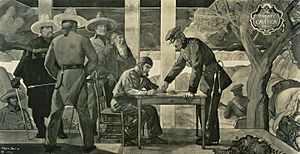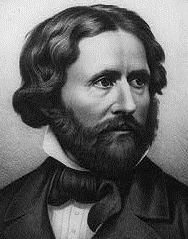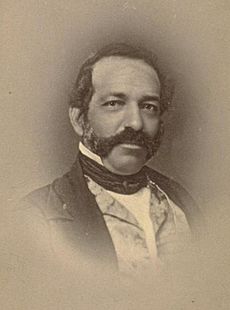Treaty of Cahuenga facts for kids

|
|
| Signed | January 13, 1847 |
|---|---|
| Location | Campo de Cahuenga, California |
The Treaty of Cahuenga (also known as the Capitulation of Cahuenga) was an important agreement signed in 1847. It officially ended the fighting in California during the Mexican–American War. This treaty created a ceasefire, meaning the fighting stopped, between the Californios (people of Mexican heritage living in California) and the American forces.
The treaty was signed on January 13, 1847, at a place called Campo de Cahuenga. It brought an end to the battles of the Mexican-American War in what was then called Alta California (which is now the state of California). The agreement was written in both English and Spanish by José Antonio Carrillo. It was signed by John C. Frémont for the American side and Andrés Pico for the Mexican forces.
The treaty asked the Californios to give up their cannons and other weapons. It also said that all prisoners from both sides should be set free right away. Californios who promised not to fight again during the war and to follow United States laws were allowed to go back to their homes and ranches peacefully. They were given the same rights as citizens of the United States. They did not have to promise loyalty to the U.S. until a full peace treaty was signed between the two countries. They also had the choice to leave the country if they wanted to.
Later, in 1848, the Treaty of Guadalupe Hidalgo was signed. This treaty officially gave Alta California and other lands from Mexico to the United States. It also set the border of Texas at the Rio Grande river. Andrés Pico, like most Californios, became an American citizen. He had full legal and voting rights. Pico later became a State Assemblyman and then a State Senator for Los Angeles. He served in the California State Legislature.
How the Treaty of Cahuenga Came About
On December 27, 1846, John C. Frémont and his group, the California Battalion, were marching south to Los Angeles. They arrived in Santa Barbara, which was empty, and put up the American flag. Frémont stayed at a hotel near the home of Bernarda Ruiz de Rodriguez. She was a rich, educated, and important woman in Santa Barbara. Four of her sons were fighting on the Mexican side.
Bernarda asked to speak with Frémont for ten minutes, but their talk lasted two hours. She told him that making a fair and generous peace would be good for his political future. She suggested that this peace should include a pardon for Pico, the release of prisoners, equal rights for all Californians, and respect for their property.
Frémont later wrote that Bernarda wanted to end the war. She wanted to do it with fair and friendly terms that would make the peace last. She hoped he would consider her plan, and she would influence her people. She also asked him to stop fighting as much as possible. Frémont promised to remember her wishes when the time came. The next day, Bernarda went with Frémont as he continued his march south.
On January 8, 1847, Frémont reached San Fernando. On January 10, the armies of Commodore Robert F. Stockton and Brigadier Stephen W. Kearny took Los Angeles back without any fighting. Frémont found out about this the next day. On January 12, Bernarda went alone to General Andres Pico's camp. She told him about the peace agreement she and Frémont had discussed. Frémont and two of Pico's officers agreed to the terms for surrender. José Antonio Carrillo wrote down the terms in both English and Spanish. The first seven parts of the treaty were almost exactly what Bernarda Ruiz de Rodriguez had suggested.
On January 13, at a ranch near the Cahuenga Pass, the treaty was signed. Bernarda Ruiz de Rodriguez was there. John Frémont, Andres Pico, and six others signed the agreement. This became known as the Treaty of Cahuenga. The treaty was signed by a Mexican military leader and a U.S. army colonel. It was done without the official support of the American or Mexican governments. Even the top U.S. officers in the area, General Kearny and Commodore Stockton, did not know about it. Still, both national governments eventually honored it. The local American and Californio people followed it right away and permanently. The fighting stopped, ending the war in California.
On January 14, the California Battalion entered Los Angeles during a rainstorm. Frémont gave the treaty to Commodore Robert Stockton. Kearny and Stockton decided to accept the generous terms Frémont offered to end the fighting. This was even though Andres Pico had broken an earlier promise not to fight U.S. forces. The next day, Stockton approved the Treaty of Cahuenga in a message he sent to the Secretary of the Navy.
Celebrating the Treaty of Cahuenga
Every year, around the date the treaty was signed, a historical ceremony takes place. It is held at the Campo de Cahuenga State Historic Park. Sometimes, people who are descendants of those involved come to the event. Actors also re-create this important historical moment.
See also
 In Spanish: Tratado de Cahuenga para niños
In Spanish: Tratado de Cahuenga para niños



